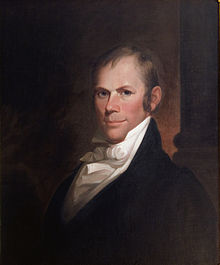Presidency of John Quincy Adams
No candidate won a majority of Electoral College votes, and so the United States House of Representatives chose the president in a contingent election.
The followers of Adams organized themselves more loosely as the National Republican Party, but were unable to match the efforts of the Democrats under Jackson, who won the 1828 election in a landslide.
[2] Crawford favored state sovereignty and a strict constructionist view of the Constitution, while Calhoun, Clay, and Adams all embraced federally-funded internal improvements, high tariffs, and the national bank.
[5] As 1824 approached, General Andrew Jackson jumped into the race, motivated in large part by his anger over Clay and Crawford's denunciations of his actions in Spanish Florida during the First Seminole War.
[1] While the other candidates based their candidacies on their long tenure as congressmen, ambassadors, or members of the cabinet, Jackson's appeal rested on his military service, especially in the Battle of New Orleans.
[6] During his sporadic service in Congress, Jackson had not earned a reputation for advocating any particular policies, though he had voted for the General Survey Act of 1824, a measure designed to help establish a national infrastructure network.
[13] Adams was sworn in as president by Chief Justice John Marshall on March 4, 1825, in a ceremony held in the House of Representatives Chamber at the United States Capitol.
[18] Samuel L. Southard of New Jersey stayed on as Secretary of the Navy, while William Wirt, who had strong ties to both Virginia and Maryland, kept his post of Attorney General.
Adams made the nomination in December 1828, and the Jacksonians of the lame-duck Senate refused to confirm Crittenden, leaving a vacancy for Jackson to fill.
Noting the healthy status of the treasury and the possibility for more revenue via land sales, Adams argued for the completion of several projects that were in various stages of construction or planning, including a road from Washington to New Orleans.
[5] The domestic agenda of Adams and Clay, which would come to be known as the American System, was designed to unite disparate regional interests in the promotion of a thriving national economy.
[31] Clay warned the president that many of his proposals held little chance of passage in the 19th Congress, but Adams noted that his agenda might be adopted at some point in the future.
[44] Between 1824 and 1828, the United States Army Corps of Engineers conducted surveys for a bevy of potential roads, canals, railroads, and improvements in river navigation.
Denmark Vesey's failed slave rebellion in 1822 also contributed to a shift in Calhoun's politics, and he would become an increasingly ardent advocate of the doctrine of states' rights during the 1820s.
[54] Aside from Clay, Adams lacked strong supporters outside of the North, and Edward Everett, John Taylor, and Daniel Webster served as his strongest advocates in Congress.
[57] Van Buren's ultimate goal, meanwhile, was the revival of the Jefferson-era alliance between Southern planters and the "plain Republicans" of the North,[60] which in turn would help recreate the old partisan split between Democratic-Republicans and Federalists.
Drawing on the recent debate over the Missouri Compromise, Van Buren feared that the failure to create a two-party system would leave the country split by sectional, rather than partisan, issues.
[61] Unlike Van Buren, Adams clung to the hope of a non-partisan nation, and he refused to make full use of the power of patronage to build up his own party structure.
[64] Adams also failed to rally strong support from the fledgling Anti-Masonic movement or from the followers of influential New York Governor DeWitt Clinton.
[71] Allies of Adams lost control of Congress after the 1826 mid-term elections, and pro-Adams Speaker of the House John Taylor was replaced by Andrew Stevenson, a Jackson supporter.
[82] Though many saw Troup as unreasonable in his dealings with the federal government and the Native Americans, the administration's handling of the incident alienated those in the Deep South who favored immediate Indian removal.
[84] His administration reached reciprocity treaties with a number of nations, including Denmark, the Hanseatic League, the Scandinavian countries, Prussia, and the Federal Republic of Central America.
In response to U.S. pressure, the British had begun to allow a limited amount of American imports to the West Indies in 1823, but U.S. leaders continued to seek an end to Britain's protective Imperial Preference system.
[30] Van Buren saw the Panama Congress as an unwelcome deviation from the more isolationist foreign policy established by President George Washington,[95] while Calhoun was eager to discredit a Clay initiative.
[96] In 1825, Antonio José Cañas, the Federal Republic of Central America's (FCRA) ambassador to the United States, proposed a treaty to provide for the construction of a canal across Nicaragua.
[88] Gallatin favored partitioning Oregon Country at the Columbia River, but Adams and Clay were unwilling to concede territory below the 49th parallel north.
[107] Vice President Calhoun joined Jackson's ticket, while Adams turned to Secretary of the Treasury Richard Rush as his running mate after Governor John Andrew Shulze of Pennsylvania declined the role.
[113] No future presidential candidate would match Jackson's proportion of the popular vote until Theodore Roosevelt's 1904 campaign, while Adams's loss made him the second one-term president, after his own father.
The coalition of Jacksonians, Calhounites, and Crawfordites built by Jackson and Van Buren would become the Democratic Party, which dominated presidential politics in the decades prior to the Civil War.
He is remembered as a great secretary of state and a man eminently qualified for the presidency, yet hopelessly weakened in his presidential leadership potential as a result of the election of 1824.



